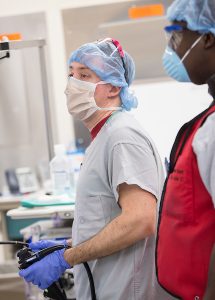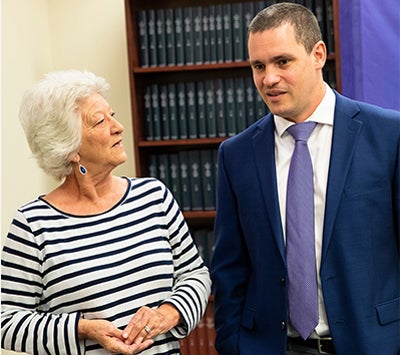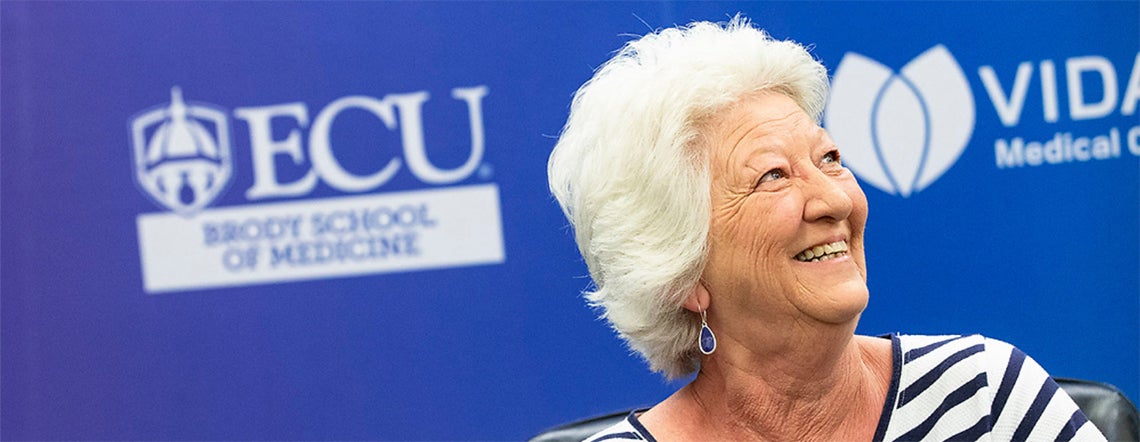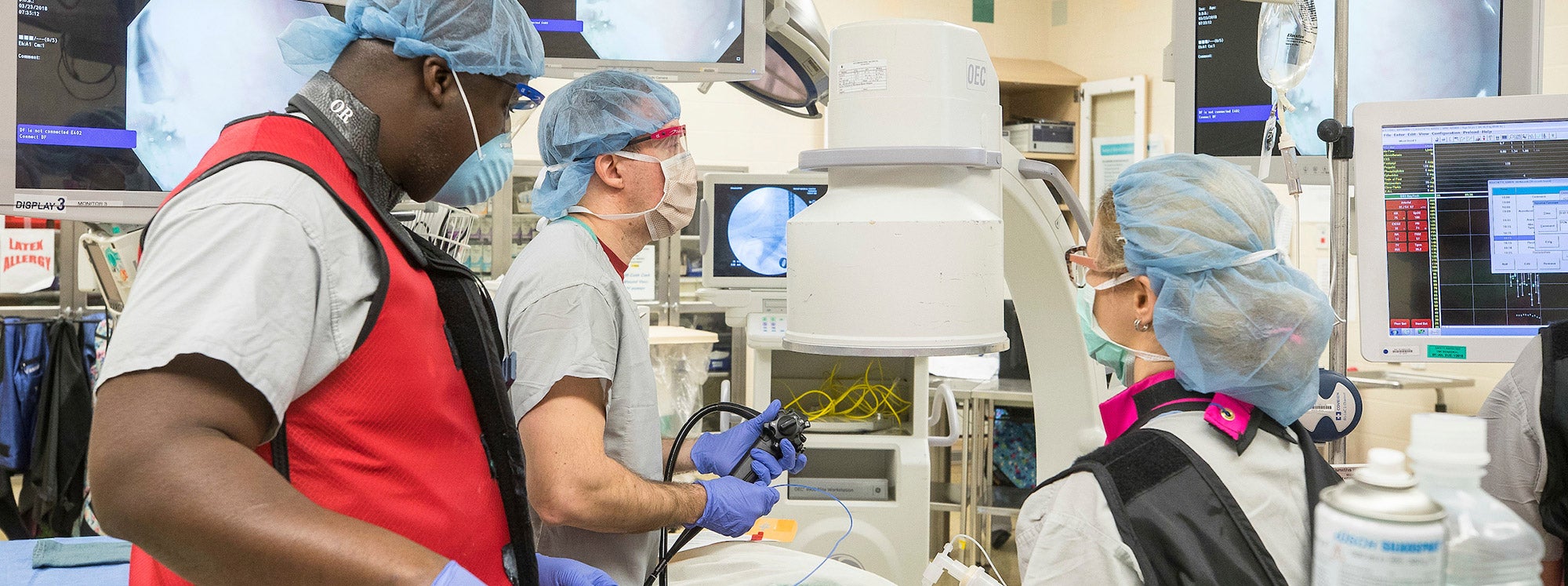TREATING ACHALASIA
New procedure helping ECU, Vidant Health surgeons treat dangerous disorder
Eating is one of the basic functions of life, but something that is often not possible for the approximately 200,000 U.S. residents living with achalasia.
The rare disorder occurs when a muscle between the esophagus and stomach loses its ability to relax, making it difficult for food and liquid to pass into a person’s stomach and causing a host of serious health problems, including weight loss and an increased risk of esophageal cancer.

Dr. James Speicher, assistant professor in ECU’s Division of Thoracic Surgery.
A team of East Carolina University surgeons at Vidant Medical Center was among the first in North Carolina to perform a minimally invasive procedure – called a Peroral Endoscopic Myotomy (POEM) – that can relieve the symptoms of achalasia and return a sense of normalcy to the lives of those it affects.
During the procedure, an endoscope – a flexible tube with a camera on it – is inserted into the esophagus and then an incision is made on the inside of the esophagus using that camera and instruments attached to the camera. The muscle inside of the esophagus that is not functioning properly is then cut to allow food easier passage to the stomach.
“It’s a new technique, which is completely endoscopic, with no incisions at all in the abdominal wall. This allows for less pain for the patient, shorter recovery times and may lead to better outcomes,” Dr. James Speicher, an assistant professor in ECU’s Division of Thoracic Surgery, said of the POEM procedure, which was first conducted in Japan in 2008 and has since slowly migrated to the rest of the world.
Just 10 months after performing their first POEM procedure, the ECU surgeons have completed approximately two dozen more and have found themselves in the forefront statewide and regionally in the treatment of achalasia.
“We pride ourselves in having the full spectrum of treatments available to treat this disease, where all of our surgeons feel comfortable with treatment at any of the stages of achalasia,” said Dr. Carlos Anciano, an assistant professor in ECU’s Division of Thoracic Surgery. “Patients no longer have to look into doing interstate and trans-country travels to obtain these cutting-edge technologies or approaches. We’re starting to see patients from other parts of the state and from other states who are now coming to ECU and Vidant for this treatment.”
Running out of options
Sandra Callis first started having difficulty eating about 12 years ago, but was told by a doctor that that it was due to acid reflux.

Dr. Carlos Anciano talks with his patient, Sandra Callis.
The Colerain grandmother of 12 took medication to treat the reflux, but the problem worsened to the point where she started having symptoms similar to a heart attack.
“I went to the hospital and they told me it was acid reflux,” said Callis, 62. “I told my husband that I’ll probably fall over dead one day from a heart attack, because I thought it was the reflux.”
About nine months ago, Callis started having difficulty eating almost anything without feeling like she was choking and having to throw it back up.
“There was no rhyme or reason. When you have reflux, people will say to just figure out what you ate before you had an attack. Mine was getting to the point where it was anything I ate,” she said. “Three bites of rice, and I’d be in the bathroom.”
Callis said she was embarrassed about her symptoms, so she tried to keep them to herself. Only her husband of 37 years, David, knew how bad it was getting because he could see her eyes watering before she excused herself from a table or family gatherings.
“(Our family) never knew. If they came over for some food, they didn’t know if grandma was eating or not, because she was busy waiting on them,” David Callis said. “I guess she hid it pretty good.”
Callis was losing weight, losing food options and losing hope.
“I started thinking that I was going to have to start drinking milkshakes for three meals a day,” she said.
Then one day while on her way to the beach, she turned on her car radio and was introduced to achalasia.
A return to normalcy
After consulting with her local gastroenterologist, Callis was diagnosed with achalasia and told that the nearest specialists performing the POEM procedure were at Johns Hopkins University in Baltimore and at ECU.
“I would’ve driven from here to John Hopkins if they would’ve told me it would’ve worked,” Callis said. “So that was nice to be only an hour away from Greenville.”
Anciano performed the POEM procedure on Callis on Feb. 5. Two weeks later, after adhering to a post-operation liquid diet, Callis was given the green light to try “normal” food again.
“I came home and had a cheeseburger. It took me an hour to eat it, because my stomach wasn’t used to food. But it sure was good and I was fine. I was full,” she said. “It was nice, it felt normal. I had forgotten what normal felt like.”
While achalasia is not a common disease, Anciano said there is a significant population in eastern North Carolina that seems to be affected by it, so the ECU team at Vidant Medical Center worked to bring the newest approaches in the management of the condition to the region.
“We were the first group of surgeons that could offer the entirety of the gamut of approaches to achalasia. … That’s important to have, so you feel that your patients have access to any of the therapies, whether they are cutting edge or traditional, so we can adapt the best way toward what the patient needs,” Anciano said. “That’s the goal of this. We don’t do this because it’s a newer technology or a newer gimmick, we do it because the patients have better outcomes.”
Even though the ECU surgeons were at the forefront of bringing the POEM procedure to North Carolina, Speicher said there is more work to be done.
“Our thoracic surgery group has been on the forefront of a lot of advancements recently,” Speicher said. “We’re all dedicated to what we do and are dedicated toward advancing the techniques and procedures we offer toward having the best possible outcomes. Our goal is to be the best in the area.”
There are moments of victory to enjoy along the way, however.
“When you’re talking about a patient with achalasia and you’re actually seeing them swallow solid food for the time in years. You can see tears almost hit their eyes,” Anciano said. “Something as simple as that turns out quite fulfilling.”

Sandra Callis
